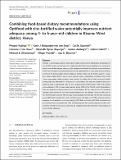| dc.contributor.author | Prosper Kujinga, Karin J Borgonjen‐van den Berg, Cecilia Superchi, Hermine J Ten Hove, Elizabeth Opiyo Onyango, Pauline Andang'o, Valeria Galetti, Michael B Zimmerman, Diego Moretti, Inge D Brouwer | |
| dc.date.accessioned | 2020-08-14T07:40:47Z | |
| dc.date.available | 2020-08-14T07:40:47Z | |
| dc.date.issued | 2018-04 | |
| dc.identifier.uri | https://repository.maseno.ac.ke/handle/123456789/2110 | |
| dc.description.abstract | Children in developing countries often face multiple micronutrient deficiencies. Introduction of zinc‐fortified water can increase zinc intake, but additional recommendations are required to address overall diet nutrient adequacy. We developed and tested food‐based recommendations (FBRs) that included zinc‐fortified water for children aged between 4 and 6 years from rural Kenya to achieve the best possible nutrient adequacy. Dietary intakes of 60 children aged 4–6 years, from Kisumu West district, Kenya, were assessed using a quantitative multipass 24‐hr recall. Linear programming model parameters were derived, including a list of foods consumed, median serving sizes, and distribution of frequency of consumption. By using the Optifood linear programming tool, we developed FBRs for diets including zinc‐fortified water. FBRs with nutrient levels achieving ≥70% recommended nutrient intake (RNI) of the … | en_US |
| dc.publisher | John Wiley & Sons Ltd | en_US |
| dc.subject | Optifood, children, diets, water, zinc. | en_US |
| dc.title | Combining food‐based dietary recommendations using Optifood with zinc‐fortified water potentially improves nutrient adequacy among 4‐to 6‐year‐old children in Kisumu West … | en_US |
| dc.type | Article | en_US |

